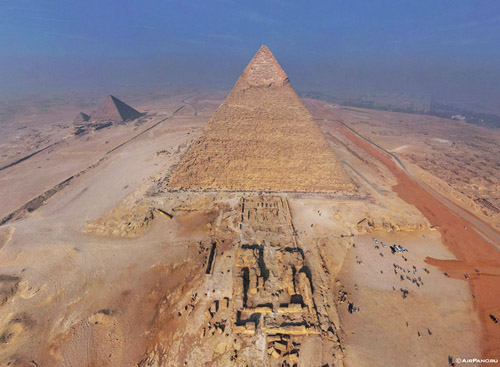Front Page Magazine has this on the recent murmurings to destroy the “pagan” Great Pyramids of Egypt by Muslims:
According to several reports in the Arabic media, prominent Muslim clerics have begun to call for the demolition of Egypt’s Great Pyramids—or, in the words of Saudi Sheikh Ali bin Said al-Rabi‘i, those “symbols of paganism,” which Egypt’s Salafi party has long planned to cover with wax. Most recently, Bahrain’s “Sheikh of Sunni Sheikhs” and President of National Unity, Abd al-Latif al-Mahmoud, called on Egypt’s new president, Muhammad Morsi, to “destroy the Pyramids and accomplish what the Sahabi Amr bin al-As could not.”
This is a reference to the Muslim Prophet Muhammad’s companion, Amr bin al-As and his Arabian tribesmen, who invaded and conquered Egypt circa 641. Under al-As and subsequent Muslim rule, many Egyptian antiquities were destroyed as relics of infidelity. While most Western academics argue otherwise, according to early Muslim writers, the great Library of Alexandria itself—deemed a repository of pagan knowledge contradicting the Koran—was destroyed under bin al-As’s reign and in compliance with Caliph Omar’s command.
The Islamist destruction underway in Timbuktu (including the tomb of Sidi Mahmoudou, d. 955, and the doors of the Sidi Yahya Mosque, ca. 1400) raises a question: What is it about Islam that so often turns its adherents against their own patrimony? Consider some examples:
☪ The doors of the Sidi Yahya Mosque, built ca. 1400, which were only to open at the end of time, smashed apart today by Islamists.
☪ The destruction of Hindu temples in medieval India.
☪ The Mamluks using the Great Sphinx of Egypt as target practice and the Great Pyramid as a quarry.
☪ The Turkish destruction of churches in northern Cyprus since 1974.
☪ The Saudi destruction of antiquities in Mecca since the 1990s,
☪ The Palestinian sacking of the Tomb of Joseph in 2000.
☪ The Taliban destruction of the Bamiyan Buddha in 2001.
☪ Al-Qaeda’s bombing of Ghriba synagogue in Tunisia in 2002,
☪ The pillaging of Iraqi museums, libraries, and archives in 2003.
☪ The destruction of an historic Malaysian Hindu temple in 2006.
☪ The destruction of L’Institut d’Égypte in 2011.
In addition, some intentions to destroy antiquities (Khomeini contemplated razing Persepolis, a grand mufti of Egypt banned exhibiting statues) might yet be realized. (On the other hand, the story about Muslims burning the ancient Library of Alexandria appears apocryphal.)
Although these examples include both non-Muslim and Muslim artifacts, motives differ in the two cases: eliminating infidel remnants establishes the superiority of Islam, while eliminating Muslim ones establishes the superiority of Islamism. In both cases, the motive is foul and the results are, historically speaking, tragic. (July 2, 2012)
